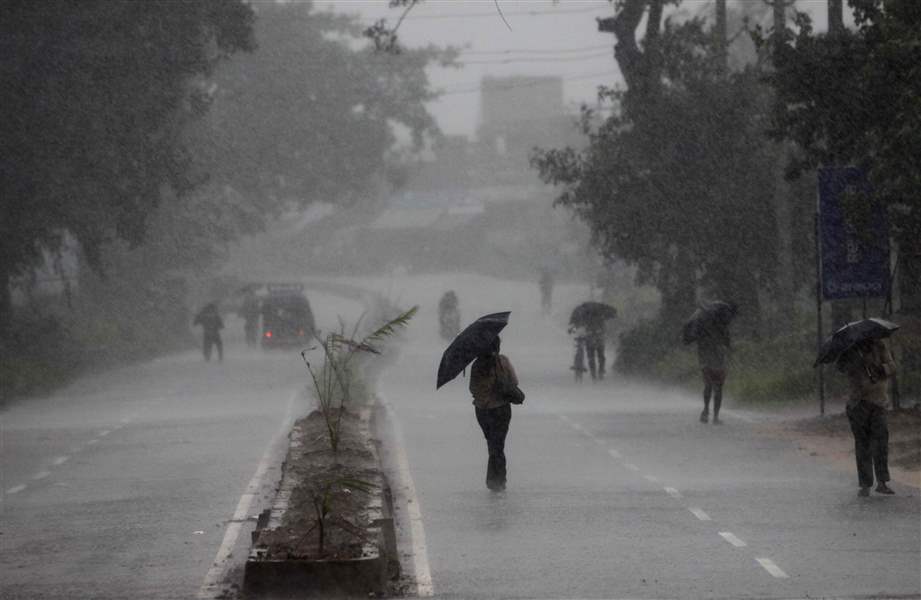
Wind, rain, seawater pound eastern India as immense, powerful cyclone roars toward coast
10/12/2013
Indians hold umbrellas as they head to a cyclone shelter in Chatrapur in Ganjam district, today, about 125 miles from the eastern Indian city Bhubaneswar, India.
ASSOCIATED PRESS

Indians hold umbrellas as they head to a cyclone shelter in Chatrapur in Ganjam district, today, about 125 miles from the eastern Indian city Bhubaneswar, India.
BHUBANESHWAR, India — Strong winds and heavy rains pounded India’s eastern coastline today, as hundreds of thousands of people took shelter from a massive, powerful cyclone that was expected to reach land in a few hours.
The skies were dark — almost black — at midday in parts of Orissa state, which will bear the brunt of the cyclone, and by mid-afternoon the winds were so strong that they could blow over grown men. Along the coast, seawater was pushing inland, swamping villages where many people survive as subsistence farmers in mud and thatch huts.
By Friday evening, some 600,000 people had been moved to higher ground or shelters in Orissa, said Surya Narayan Patro, the state’s top disaster management official.
Several hours before Cyclone Phailin’s expected landfall, meteorologists hoped it might hit while in a temporary weakened state. But no matter what, it was forecast to be large and deadly. Satellite images showed the cyclone filling nearly the entire Bay of Bengal, an area larger than France.
“A storm this large can’t peter out that fast,” said Ryan Maue, a meteorologist at Weather Bell, a private U.S. weather firm. “There’s nothing to stop it at this point.”
Maue said that even in the best-case scenario there would be a storm surge of 20-30 feet.
A storm surge — the giant wall of water that that a cyclone blasts ashore — is the big killer in these storms.
Phailin already has been large and powerful for nearly 36 hours, he said, and those winds have built up a tremendous amount of surge.
A few hours before the storm was to hit this evening, about 200 villagers were jammed into a two-room schoolhouse in the village of Subalaya, about 30 kilometers (20 miles) from the coast, where local emergency officials were distributing food and water. The roads were almost completely empty of traffic by this afternoon, but two trucks pulled up to the school with more evacuees. Children shivered in the rain as they stepped down from the vehicles, following women carrying bags jammed with possessions.
Many of the people had fled low-lying villages for the shelter of the concrete school. But some had also left behind relatives who feared the storm could wipe out lifetimes of work.
“My son had to stay back with his wife because of the cattle and belongings,” said 70-year-old Kaushalya Jena, weeping in fear inside the makeshift shelter. “I don’t know if they are safe.”
The Indian Meteorological Department warned that Phailin was a “very severe cyclonic storm,” and that it would hit Orissa and Andhra Pradesh states with maximum sustained winds of 130-135 miles per hour.
But the U.S. Navy’s Joint Typhoon Warning Center in Hawaii forecast maximum sustained winds of 167 mph, with gusts up to 196 mph.
Indian officials also made less dire predictions about the storm surge, saying only that it would be at least 10 feet high.
In Bhubaneshwar, the Orissa state capital, government workers and volunteers were putting together hundreds of thousands of food packages to be distributed at relief camps.
The state’s top official, Chief Minister Naveen Patnaik, appealed for people to leave their homes if they are ordered.
“I request everyone to not panic. Please assist the government. Everyone from the village to the state headquarters have been put on alert,” he told reporters.
Patro said tens of thousands of more people would be moved to safer areas before the cyclone hits. “No one will be allowed to stay in mud and thatched houses in the coastal areas,” he said.
In Paradip, the Orissa port city hammered in a 1999 cyclone, at least seven ships were moved out to sea to ride out the storm, with other boats shifted to safer parts of the harbor, officials said.
U.S. forecasters repeatedly warned the storm would be immense.
“If it’s not a record, it’s really, really close,” University of Miami hurricane researcher Brian McNoldy told The Associated Press. “You really don’t get storms stronger than this anywhere in the world ever. This is the top of the barrel.”
To compare it to killer U.S. storms, McNoldy said Phailin is nearly the size of Hurricane Katrina, which killed 1,200 people in 2005 and caused devastating flooding in New Orleans, but also has the wind power of 1992’s Hurricane Andrew, which packed 265 kph (165 mph) winds at landfall in Miami.
The storm is expected to cause large-scale power and communications outages and shut down road and rail links, officials said. It’s also expected to cause extensive damage to crops.
In Andhra Pradesh, the government evacuated at least 64,000 people from low-lying areas, said state Revenue Minister N. Raghuveera Reddy.
The sea had already pushed inland as much as 130 feet in parts of the state.
Officials have been stockpiling emergency food supplies, and setting up shelters for evacuees. The Indian air force said four transport planes and 18 helicopters were being kept ready for relief operations in the region.
The Bay of Bengal has been the scene of some of the deadliest storms in recent history. The 1999 Orissa cyclone, which was similar in strength to Phailin, killed 10,000 people.